Polyethylene Glycol-Isophorone Diisocyanate Polyurethane Prepolymers Tailored Using MALDI MS
Abstract
1. Introduction
2. Materials and Methods
- Reactive samples: Samples from the reaction mixture were rapidly introduced in dry THF and mixed using a Vortex-Genie 2 device. The DCTB matrix was prepared in THF at a concentration of 10 mg/mL, while the NaI concentration in THF was 5 mg/mL.
- Quenched samples: Samples from the reaction mixture were introduced in MeOH for 24 h to quench the reactive NCO groups. The DHB matrix and NaI solutions were prepared in methanol at concentrations of 20 mg/mL, and, respectively, 5 mg/mL.
3. Results and Discussion
- Temperature influence—MALDI MS
- Concentration influence
- Catalyst influence
4. Conclusions
Supplementary Materials
Author Contributions
Funding
Institutional Review Board Statement
Informed Consent Statement
Data Availability Statement
Acknowledgments
Conflicts of Interest
References
- Szycher, M. Szycher’s Handbook of Polyurethanes, 2nd ed.; CRC Press: Boca Raton, FL, USA, 2013. [Google Scholar]
- Selvasembian, R.; Gwenzi, W.; Chaukura, N.; Mthembu, S. Recent advances in the polyurethane-based adsorbents for the decontamination of hazardous wastewater pollutants. J. Hazard. Mater. 2021, 417, 125960. [Google Scholar] [CrossRef] [PubMed]
- Kim, B.K.; Paik, S.H. UV-curable poly(ethylene glycol)–based polyurethane acrylate hydrogel. J. Polym. Sci. Part A Polym. Chem. 1999, 37, 2703–2709. [Google Scholar] [CrossRef]
- Shelke, N.B.; Sairam, M.; Halligudi, S.B.; Aminabhavi, T.M. Development of transdermal Drug-delivery films with castor-oil-based polyurethanes. J. Appl. Polym. Sci. 2007, 103, 779–788. [Google Scholar] [CrossRef]
- Cesteros, L.C.; Ramírez, C.A.; Peciña, A.; Katime, I. Poly(ethylene glycol-β-cyclodextrin) gels: Synthesis and properties. J. Appl. Polym. Sci. 2006, 102, 1162–1166. [Google Scholar] [CrossRef]
- Cesteros, L.C.; Ramírez, C.A.; Peciña, A.; Katime, I. Synthesis and properties of hydrophilic networks based on poly(ethylene glycol) and β-cyclodextrin. Macromol. Chem. Phys. 2007, 208, 1764–1772. [Google Scholar] [CrossRef]
- Ma, C.; Hou, Y.; Liu, S.; Zhang, G. Effect of microphase separation on the protein resistance of a polymeric surface. Langmuir 2009, 25, 9467–9472. [Google Scholar] [CrossRef] [PubMed]
- Li, J.; Ma, L.; Chen, G.; Zhou, Z.; Li, Q. A high water-content and high elastic dual-responsive polyurethane hydrogel for drug delivery. J. Mater. Chem. B 2015, 3, 8401–8409. [Google Scholar] [CrossRef]
- Peng, K.; Chen, C.; Pan, W.; Liu, W.; Wang, Z.; Zhu, L. Preparation and properties of -cyclodextrin/4,4’-diphenylmethane diisocyanate/polyethylene glycol (β-CD/MDI/PEG) crosslinking copolymers as polymeric solid–solid phase change materials. Sol. Energy Mater. Sol. Cells 2016, 145, 238–247. [Google Scholar] [CrossRef]
- Yan, H.; Zhou, Z.; Pan, Y.; Huang, T.; Zhou, H.; Liu, Q.; Huang, H.; Zhang, Q.; Wang, W. Preparation and properties of polyurethane hydrogels based on methylene diphenyl diisocyanate/polycaprolactone-polyethylene glycol. J. Macromol. Sci. Phys. 2016, 55, 839–848. [Google Scholar] [CrossRef]
- Liu, D.E.; Chen, Q.; Long, Y.B.; Ma, J.; Gao, H. A thermo-responsive polyurethane organogel for norfloxacin delivery. Polym. Chem. 2018, 9, 228–235. [Google Scholar] [CrossRef]
- Peng, Z.; Zhou, P.; Zhang, F.; Peng, X. Preparation and properties of polyurethane hydrogels based on hexamethylene diisocyanate/polycaprolactone-polyethylene glycol. J. Macromol. Sci. B 2018, 57, 187–195. [Google Scholar] [CrossRef]
- Rodin, M.; Romanova, L.; Lapshina, M.; Terent’ev, A.; Tarasov, A. Synthesis and properties of polyurethane hydrogel based on β-cyclodextrin partial nitrates and poly(ethylene glycol). Macromol. Symp. 2019, 385, 1800161. [Google Scholar] [CrossRef]
- Maiuolo, L.; Olivito, F.; Ponte, F.; Algieri, V.; Tallarida, M.A.; Tursi, A.; Chidichimo, G.; Sicilia, E.; De Nino, A. A novel catalytic two-step process for the preparation of rigid polyurethane foams: Synthesis, mechanism and computational studies. React. Chem. Eng. 2021, 6, 1238–1245. [Google Scholar] [CrossRef]
- Peptu, C.; Diaconu, A.-D.; Danu, M.; Peptu, C.A.; Cristea, M.; Harabagiu, V. The Influence of the Hydroxyl Type on Crosslinking Process in Cyclodextrin Based Polyurethane Networks. Gels 2022, 8, 348. [Google Scholar] [CrossRef]
- Cunliffe, A.V.; Davis, A.; Farey, M.; Wright, J. The kinetics of the reaction of isophorone diisocyanate with mono-alcohols. Polymer 1985, 26, 301–306. [Google Scholar] [CrossRef]
- Bialas, N.; Hocker, H. 13C NMR studies on the relative reactivity of isocyanate groups of isophorone diisocyanate isomers. Makromol. Chem. 1990, 191, 1843–1852. [Google Scholar] [CrossRef]
- Spyrou, E.; Metternich, H.J.; Franke, R. Isophorone diisocyanate in blocking agent free polyurethane powder coating hardeners: Analysis, selectivity, quantum chemical calculations. Prog. Org. Coat. 2003, 48, 201–206. [Google Scholar] [CrossRef]
- Sardon, H.; Irusta, L.; Fernandez-Berridi, M.J. Synthesis of isophorone diisocyanate (IPDI) based waterborne polyurethanes: Comparison between zirconium and tin catalysts in the polymerization process. Prog. Org. Coat. 2009, 66, 291–295. [Google Scholar] [CrossRef]
- Karpov, S.V.; Lodygina, V.P.; Komratova, V.V.; Dzhalmukhanova, A.S.; Malkov, G.V.; Badamshina, E.R. Kinetics of urethane formation from isophorone diisocyanate: The catalyst and solvent effects. Kinet. Catal. 2015, 57, 422–428. [Google Scholar] [CrossRef]
- Karpov, S.V.; Lodygina, V.P.; Komratova, V.V.; Dzhalmukhanova, A.S.; Malkov, G.V.; Badamshina, E.R. Kinetics of urethane formation from isophorone diisocyanate: The alcohol nature effect. Kinet. Catal. 2015, 57, 319–325. [Google Scholar] [CrossRef]
- Ono, H.K.; Jones, F.N.; Pappas, S.P. Relative reactivity of isocyanate groups of isophorone diisocyanate. Unexpected high reactivity of the secondary isocyanate group. J. Polym. Sci. C Polym. Lett. 1985, 23, 509–515. [Google Scholar] [CrossRef]
- Sardon, H.; Pascual, A.; Mecerreyes, D.; Taton, D.; Cramail, H.; Hedrick, J.L. Synthesis of Polyurethanes Using Organocatalysis: A Perspective. Macromolecules 2015, 48, 3153–3165. [Google Scholar] [CrossRef]
- Pavier, C.; Gandini, A. Urethanes and polyurethanes from oxypropylated sugar beet pulp—Kinetic study in solution. Eur. Polym. J. 2000, 36, 1653–1658. [Google Scholar] [CrossRef]
- Semsarzadeh, M.A.; Navarchian, A.H. Kinetic study of the bulk reaction between TDI and PPG in presence of DBTDL and FeAA catalysts using quantitative FTIR spectroscopy. J. Polym. Eng. 2003, 23, 225. [Google Scholar] [CrossRef]
- Moller, M.; Moritz, H.U. Kinetic investigations of trimethylolpropane–diisocyanate reactions. J. Appl. Polym. Sci. 2006, 101, 4090–4097. [Google Scholar] [CrossRef]
- Sebenik, U.; Krajnc, M. Influence of the soft segment length and content on the synthesis and properties of isocyanate-terminated urethane prepolymers. Int. J. Adhes. Adhes. 2007, 27, 527–535. [Google Scholar] [CrossRef]
- Maji, P.K.; Bhowmick, A.K. Influence of number of functional groups of hyperbranched polyol on cure kinetics and physical properties of polyurethanes. J. Polym. Sci. A Polym. Chem. 2009, 47, 731–745. [Google Scholar] [CrossRef]
- Cateto, C.A.; Barreiro, M.F.; Rodrigues, A.E.; Belgacem, M.N. Kinetic study of the formation of lignin-based polyurethanes in bulk. React. Funct. Polym. 2011, 71, 863. [Google Scholar] [CrossRef]
- Burel, F.; Feldman, A.; Bunel, C. Hydrogenated hydroxy-functionalized polyisoprene (H-HTPI) and isocyanurate of isophorone diisocyanates (I-IPDI): Reaction kinetics study using FTIR spectroscopy. Polymer 2005, 46, 15–25. [Google Scholar] [CrossRef]
- Eceiza, A.; de la Caba, K.; Gascon, V.; Corcuera, M.A.; Mondragon, I. The influence of molecular weight and chemical structure of soft segment in reaction kinetics with tolyl isocyante. Eur. Polym. J. 2001, 37, 1685–1693. [Google Scholar] [CrossRef]
- Eceiza, A.; de la Caba, K.; Kortaberria, G.; Gabilondo, N.; Marieta, C.; Corcuera, M.A.; Mondragon, I. Influence of molecular weight and chemical structure of soft segment in reaction kinetics of polycarbonate diols with 4,4’-diphenylmethane diisocyanate. Eur. Polym. J. 2005, 41, 3051–3059. [Google Scholar] [CrossRef]
- Hager, S.L.; Macrury, T.B.; Gerkin, R.M.; Ceitchfield, F.E. Urethane Block Polymers-Kinetics of Formation and Phase Development. In Urethane Chemistry and Applications; Edwards, K.N., Gum, W.F., Johnson, J.E., Bailey, F.E., Jr., Graff, R.S., Glasser, W.G., Klempner, D., Frisch, K.C., Eds.; American Chemical Society: Washington, DC, USA, 1981; pp. 149–166. [Google Scholar]
- Hernandez-Sanchez, F.; Vera-Graziano, R. Determination of the kinetic parameters for the polymerization of a polyurethane using an improved method of differential scanning calorimetry. J. Appl. Polym. Sci. 1992, 46, 571–580. [Google Scholar] [CrossRef]
- Kothandaraman, H.; Sultan Nasar, A. The kinetics of the polymerization reaction of toluene diisocyanate with HTPB prepolymer. J. Appl. Polym. Sci. 1993, 50, 1611–1617. [Google Scholar] [CrossRef]
- Ismail, T.N.M.T.; Palam, K.D.P.; Bakar, Z.B.A.; Soi, H.S.; Kian, Y.S.; Hassan, H.A.; Schiffman, C.; Sendijarevic, A.; Sendijarevic, V.; Sendijarevic, I. Urethane-forming reaction kinetics and catalysis of model palm olein polyols: Quantified impact of primary and secondary hydroxyls. J. Appl. Polym. Sci. 2016, 133, 42955. [Google Scholar] [CrossRef]
- Elwell, M.J.; Ryan, A.J.; Grunbauer, H.J.M.; Van Lieshout, H.C. In-situ studies of structure development during the reactive processing of model flexible polyurethane foam systems using FT-IR spectroscopy, Synchrotron SAXS, and Rheology. Macromolecules 1996, 29, 2960–2968. [Google Scholar] [CrossRef]
- Grepinet, B.; Pls, F.; Hobbes, P.; Monge, T.; Swaels, P. Modeling and simulation of urethane acrylates synthesis. II. Kinetics of uncatalyzed reaction of toluene diisocyanate with a polyether diol. J. Appl. Polym. Sci. 2000, 81, 3149–3160. [Google Scholar] [CrossRef]
- Parnell, S.; Min, K.; Cakmak, M. Kinetic studies of polyurethane polymerization with Raman spectroscopy. Polymer 2003, 44, 5137–5144. [Google Scholar] [CrossRef]
- D’Arlas, B.F.; Rueda, L.; Stefani, P.M.; de la Caba, K.; Mondragon, I.; Eceiza, A. Kinetic and thermodynamic studies of the formation of a polyurethane based on 1,6-hexamethylene diisocyanate and poly(carbonate-co-ester)diol. Thermochim. Acta 2007, 459, 94–103. [Google Scholar] [CrossRef]
- Ionescu, M.; Petrovic, Z.S.; Wan, X. Ethoxylated soybean polyols for polyurethanes. J. Polym. Environ. 2010, 18, 1–7. [Google Scholar] [CrossRef]
- Papadopoulos, E.; Ginic-Markovic, M.; Clarke, S. Reaction kinetics of polyurethane formation using a commercial oligomeric diisocyanate resin studied by calorimetric and rheological methods. Macromol. Chem. Phys. 2008, 209, 2302–2311. [Google Scholar] [CrossRef]
- Kaushik, A.; Singh, P. Kinetics of reaction of castor oil trimethylol propane polyol and 4,4’-diphenyl methane diisocyanate. Int. J. Polym. Mater. 2008, 57, 815–831. [Google Scholar] [CrossRef]
- Wu, W.; Zeng, X.; Li, H.; Lai, X.; Yan, Z. Synthesis and characterization of polyhydroxylated polybutadiene binding 2,2′-thiobis(4-methyl-6-tert-butylphenol) with isophorone diisocyanate. J. Appl. Polym. Sci. 2014, 131, 40942. [Google Scholar] [CrossRef]
- Ghoreishi, R.; Zhao, Y.; Suppes, G.J. Reaction modeling of urethane polyols using fraction primary secondary and hindered-secondary hydroxyl content. J. Appl. Polym. Sci. 2014, 131, 40388. [Google Scholar] [CrossRef]
- Ghoreishi, R.; Suppes, G.J. Chain growth polymerization mechanism in polyurethane-forming reactions. RSC Adv. 2015, 5, 68361. [Google Scholar] [CrossRef]
- Tilly, J.C.; Pervaje, A.K.; Inglefield, D.L.; Santiso, E.E.; Spontak, R.J.; Khan, S.A. Spectroscopic and rheological cross-analysis of polyester polyol cure behavior: Role of polyester secondary hydroxyl content. ACS Omega 2019, 4, 932–939. [Google Scholar] [CrossRef] [PubMed]
- Nagy, T.; Antal, B.; Czifrak, K.; Papp, I.; Karger-Kocsis, J.; Zsuga, M.; Keki, S. New insight into the kinetics of diisocyanate-alcohol reactions by highperformance liquid chromatography and mass spectrometry. J. Appl. Polym. Sci. 2015, 132, 42127. [Google Scholar] [CrossRef]
- Nagy, T.; Antal, B.; Dékány-Adamoczky, A.; Karger-Kocsis, J.; Zsuga, M.; Keki, S. Uncatalyzed reactions of 4,4′-diphenylmethane-diisocyanate with polymer polyols as revealed by matrix-assisted laser desorption/ionization mass spectrometry. RSC Adv. 2016, 6, 47023–47032. [Google Scholar] [CrossRef]
- Chattopadhyay, D.K.; Prasada Raju, N.; Vairamani, M.; Raju, K.V.S.N. Structural investigations of polypropylene glycol (PPG) and isophorone diisocyanate (IPDI) based polyurethane prepolymer by matrix-assisted laser desorption/ionization time-of-flight (MALDI-TOF)-mass spectrometry. Prog. Org. Coat. 2008, 62, 117–122. [Google Scholar] [CrossRef]
- Nielen, M.W.F. Maldi time-of-flight mass spectrometry of synthetic polymers. Mass. Spec. Rev. 1999, 18, 309–344. [Google Scholar] [CrossRef]
- Mass, V.; Schrepp, W.; Von Vacano, B.; Pasch, H. Sequence analysis of an isocyanate oligomer by MALDI-TOF mass spectrometry using collision induced dissociation. Macromol. Chem. Phys. 2009, 210, 1957–1965. [Google Scholar] [CrossRef]
- Pasch, H.; Alpheus Mautjana, N. Matrix-assisted laser desorption/ionization mass spectrometry of polymers. In Encyclopedia of Analytical Chemistry; Meyers, R.A., Meyers, R.A., Eds.; Wiley: Hoboken, NJ, USA, 2011. [Google Scholar]
- Mautjana, N.A.; Pasch, H. Matrix-assisted laser desorption ionization mass spectrometry of synthetic polymers. Macromol. Symp. 2012, 313, 157–161. [Google Scholar] [CrossRef]
- Beldi, M.; Medimagh, R.; Chatti, S.; Marque, S.; Prim, D.; Loupy, A.; Delolme, F. Characterization of cyclic and non-cyclic poly-(ether-urethane)s bio-based sugar diols by a combination of MALDI-TOF and NMR. Eur. Polym. J. 2007, 43, 3415–3433. [Google Scholar] [CrossRef]
- Nagy, L.; Nagy, M.; Vadkerti, B.; Daróczi, L.; Deák, G.; Zsuga, M.; Kéki, S. Designed polyurethanes for potential biomedical and pharmaceutical applications: Novel synthetic strategy for preparing sucrose containing biocompatible and biodegradable polyurethane networks. Polymers 2019, 11, 825. [Google Scholar] [CrossRef]
- Warburton, K.E.; Clench, M.R.; Ford, M.J.; White, J.; Rimmer, D.A.; Carolan, V.A. Characterisation of derivatised monomeric and prepolymeric isocyanates by matrix-assisted laser desorption/ionisation time-of-flight mass spectrometry and structural elucidation by tandem mass spectrometry. Eur. J. Mass Spectrom. 2005, 11, 565–574. [Google Scholar] [CrossRef] [PubMed]
- Ahn, Y.H.; Lee, Y.J.; Kim, S.H. MALDI MS-based composition analysis of the polymerization reaction of toluene diisocyanate (TDI) and ethylene glycol (EG). Anal. Sci. 2015, 31, 513–520. [Google Scholar] [CrossRef] [PubMed]
- Ren, H.; Hu, H.; Yu, B.; Du, Y.; Wu, T. Identification of polymer building blocks by Py-GC/MS and MALDI-TOF MS. Int. J. Polym. Anal. 2017, 23, 9–17. [Google Scholar] [CrossRef]
- Wang, Z.; Zhang, Q.; Shen, H.; Yang, P.; Zhou, X. Optimized MALDI-TOF MS Strategy for Characterizing Polymers. Front. Chem. 2021, 9, 698297. [Google Scholar] [CrossRef] [PubMed]
- Lomolder, R.; Plogmann, F.; Speier, P. Selectivity of isophorone diisocyanate in the urethane reaction influence of temperature, catalysis, and reaction partners. J. Coat. Technol. 1997, 69, 51–57. [Google Scholar] [CrossRef]
- Gotz, H.; Beginn, U.; Bartelink, C.F.; Grünbauer, H.J.M.; Möller, M. Preparation of Isophorone Diisocyanate Terminated StarPolyethers. Macromol. Mater. Eng. 2002, 287, 223–230. [Google Scholar] [CrossRef]
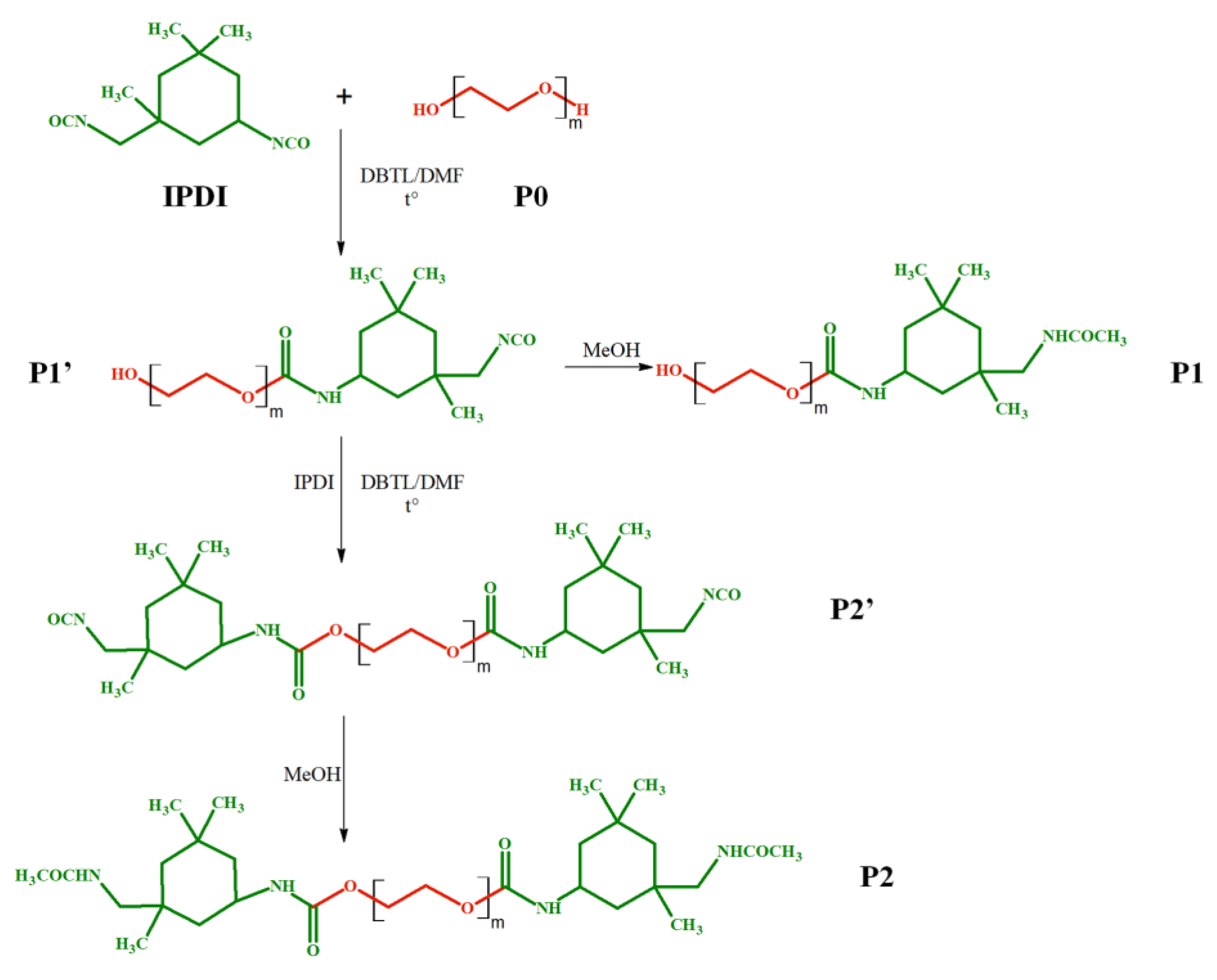
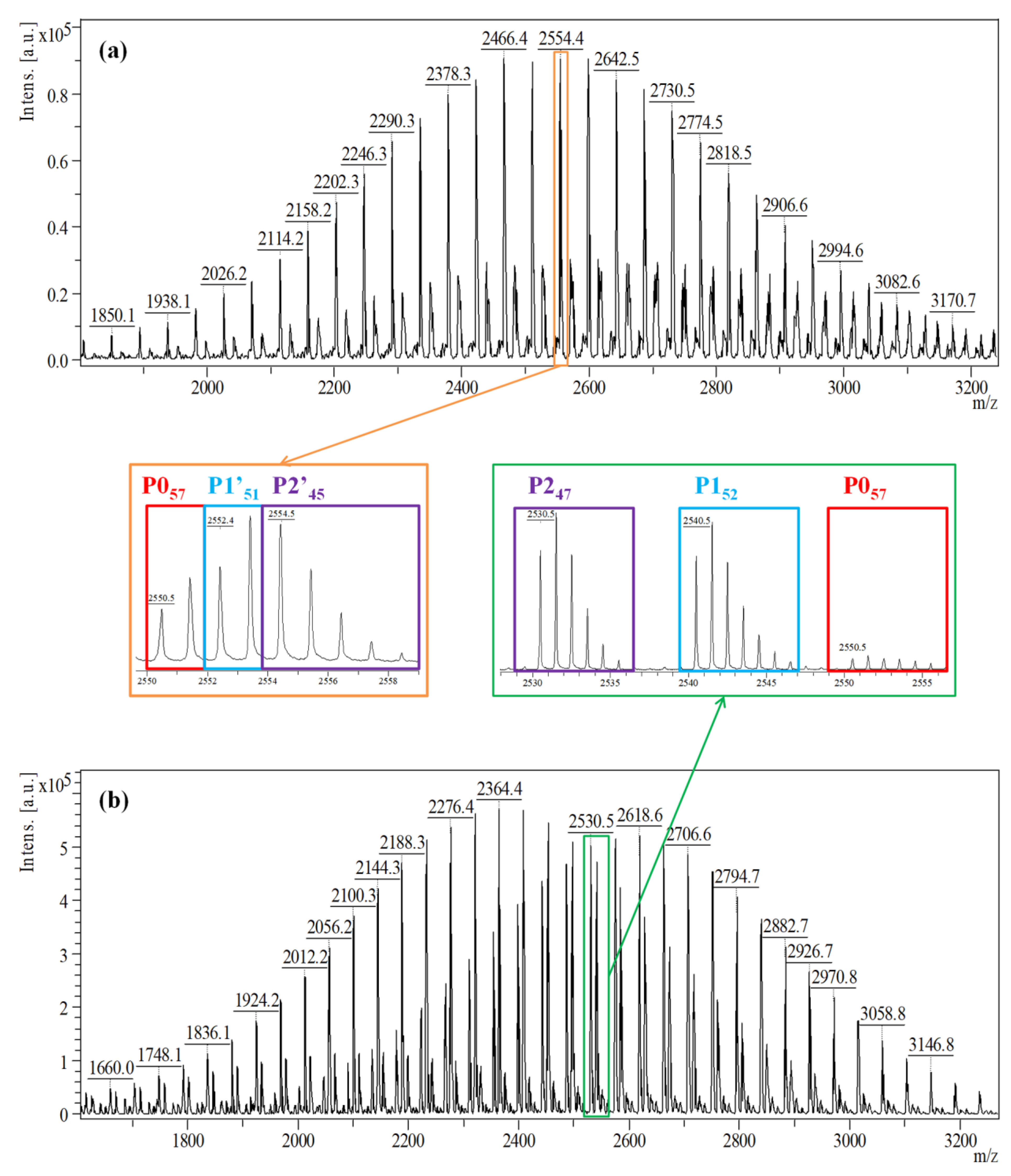
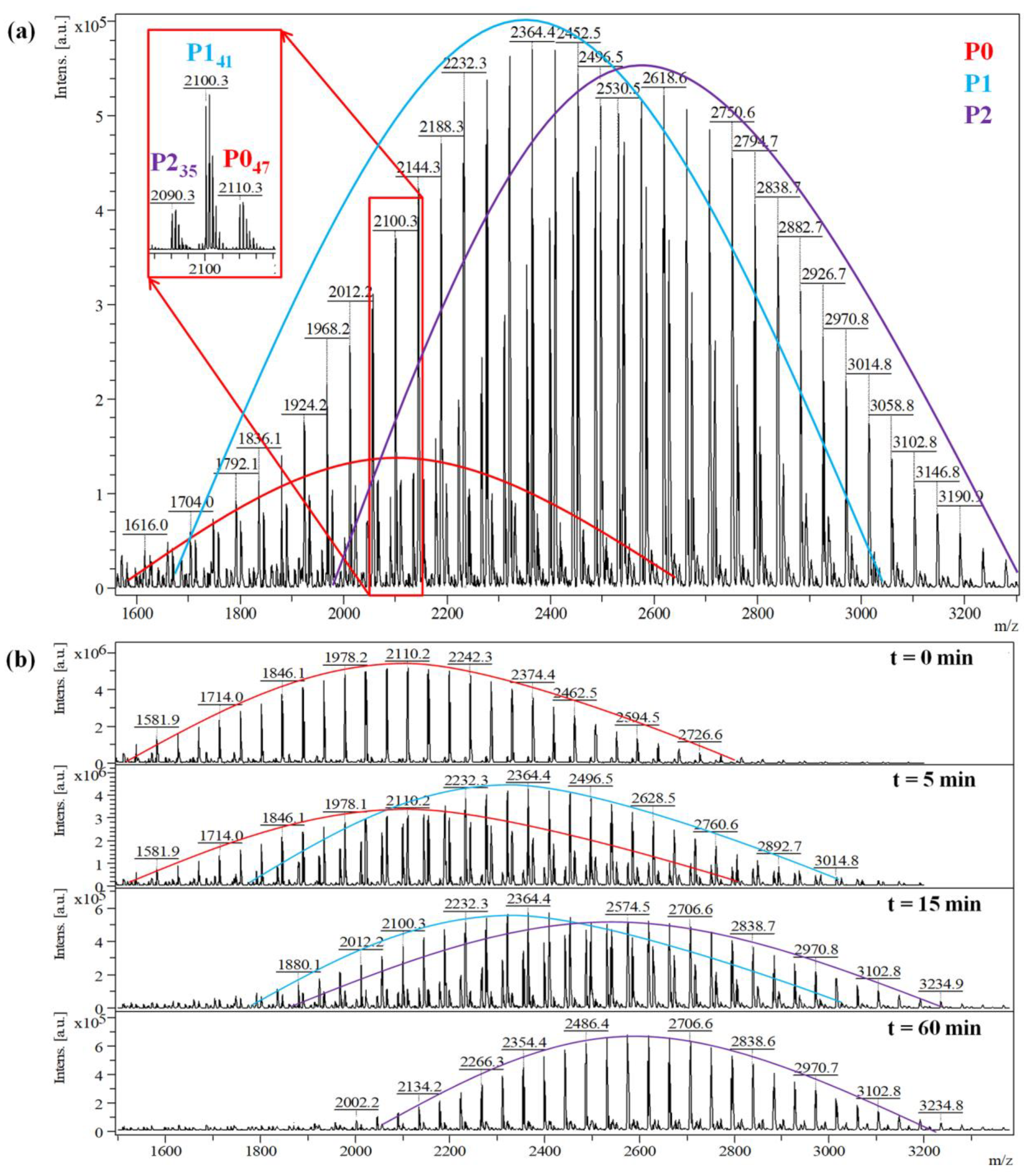

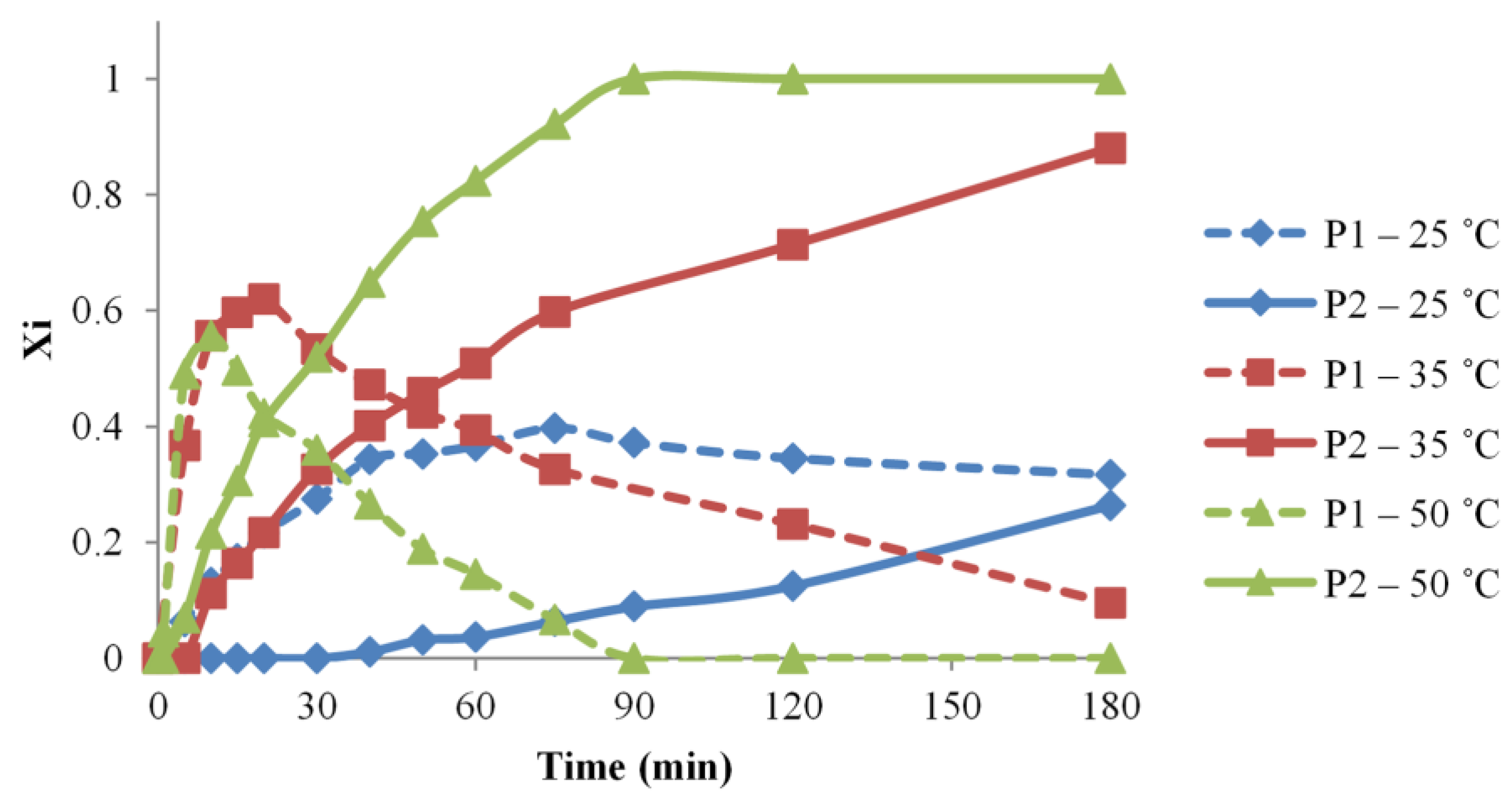
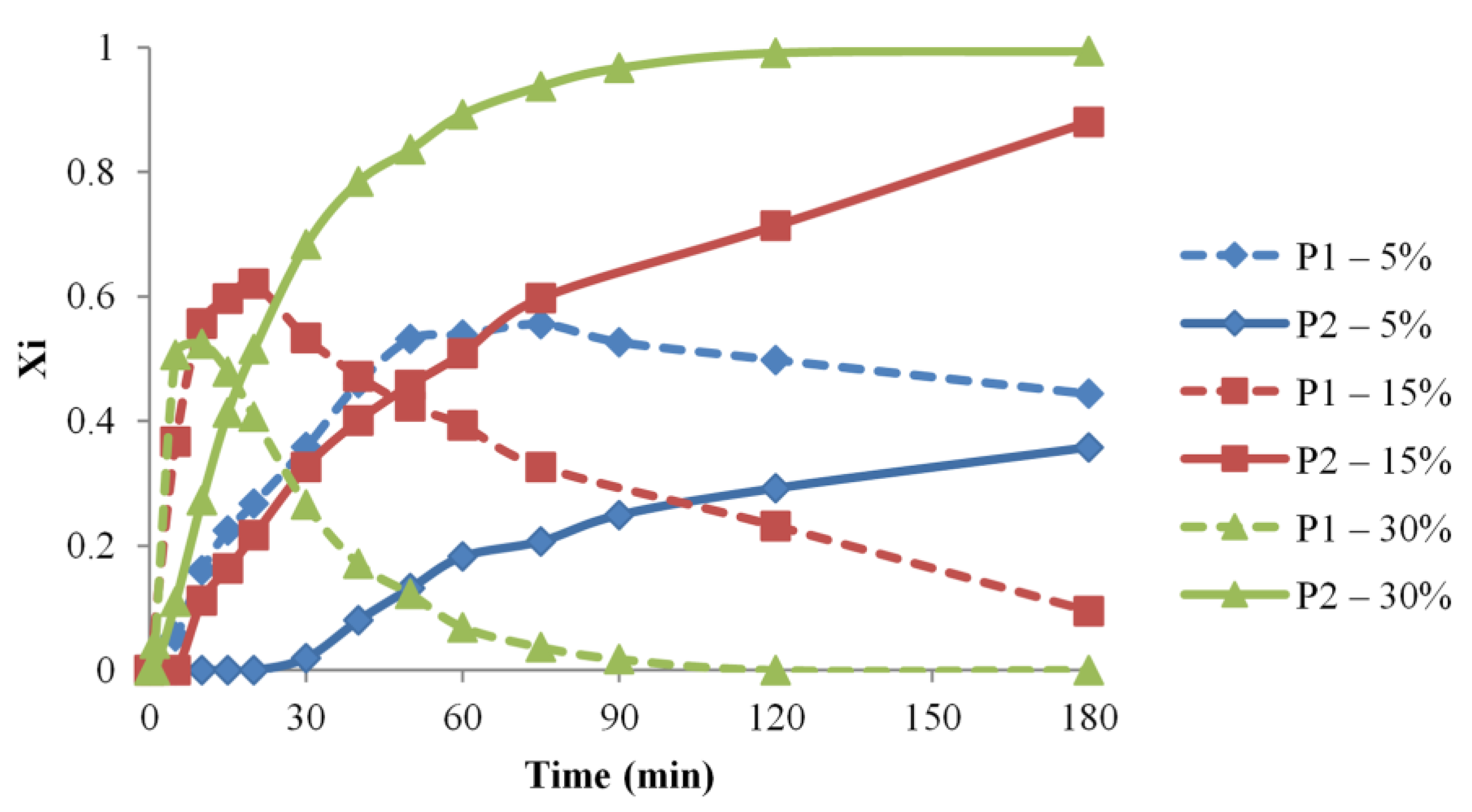
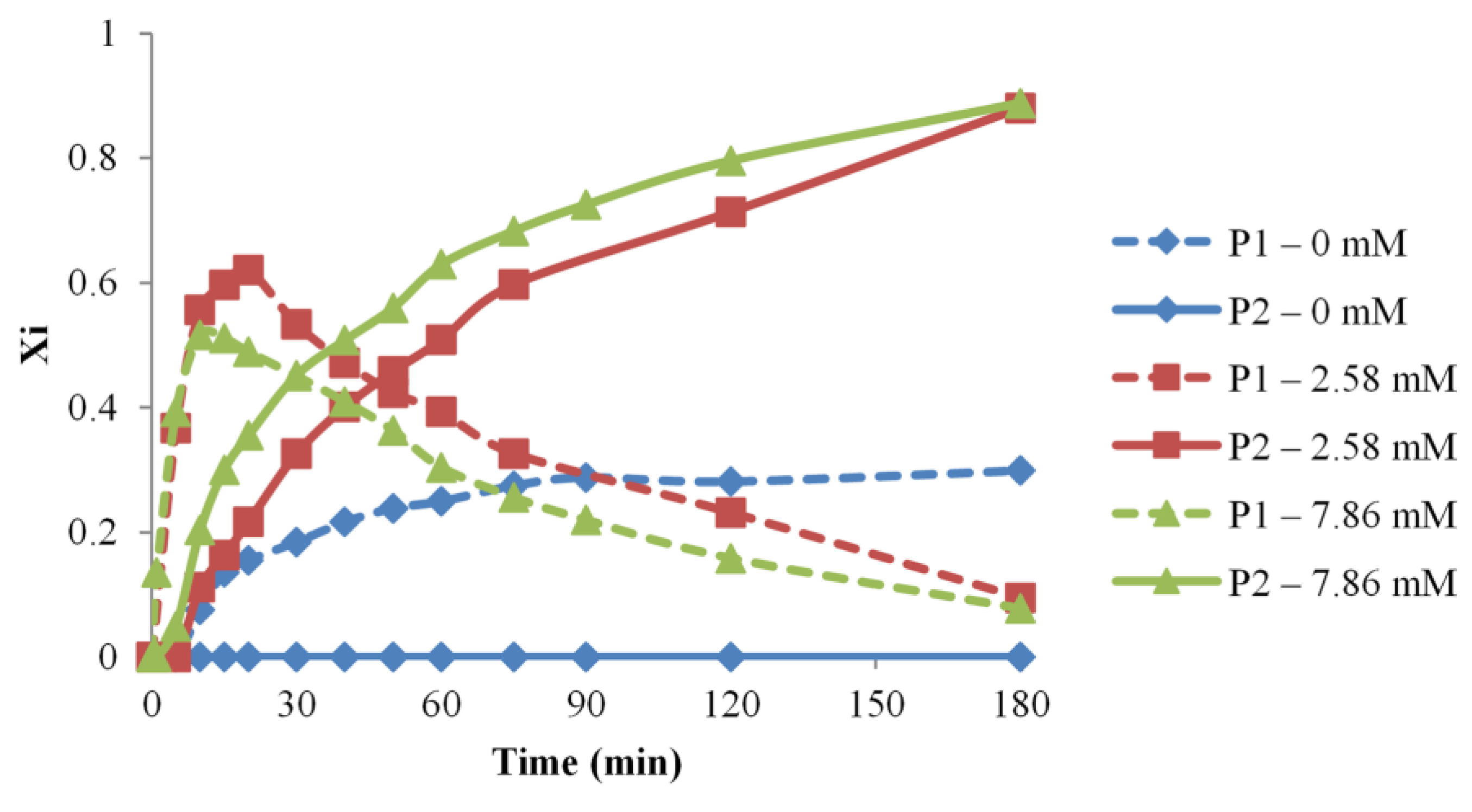
| # Sample | Temperature (°C) | %wt 1 | Molar Ratio PEG/IPDI/DBTL | kapp (min−1) |
|---|---|---|---|---|
| 1 | 35 | 15 | 1/2/0.018 | 1.13 × 10−2 |
| 2 | 35 | 30 | 1/2/0.018 | 3.81 × 10−2 |
| 3 | 35 | 5 | 1/2/0.018 | 0.29 × 10−2 |
| 4 | 35 | 15 | 1/2/0.054 | 1.59 × 10−2 |
| 5 | 50 | 15 | 1/2/0.018 | 2.75 × 10−2 |
| 6 | 25 | 15 | 1/2/0.018 | 0.09 × 10−2 |
| 7 | 35 | 15 | 1/2/0 | 0 |
| Series | m/z |
|---|---|
| P0 | 44× n (ethylene oxide units) + 18 (end groups of PEG) + 23 (Na+) |
| P1′ | 44 × n (ethylene oxide units) + 18 (end groups of PEG) + 23 (Na+) + 222 (IPDI) |
| P2′ | 44 × n (ethylene oxide units) + 18 (end groups of PEG) + 23 (Na+) + 2 × 222 (IPDI) |
| Series | m/z |
|---|---|
| P0 | 44 × n (ethylene oxide units) + 18 (end groups of PEG) + 23 (Na+) |
| P1 | 44 × n (ethylene oxide units) + 18 (end groups of PEG) + 23 (Na+) + 222 (IPDI) + 32 (MeOH) |
| P2 | 44 × n (ethylene oxide units) + 18 (end groups of PEG) + 23 (Na+) + 2 × 222 (IPDI) + 2 × 32 (MeOH) |
Disclaimer/Publisher’s Note: The statements, opinions and data contained in all publications are solely those of the individual author(s) and contributor(s) and not of MDPI and/or the editor(s). MDPI and/or the editor(s) disclaim responsibility for any injury to people or property resulting from any ideas, methods, instructions or products referred to in the content. |
© 2023 by the authors. Licensee MDPI, Basel, Switzerland. This article is an open access article distributed under the terms and conditions of the Creative Commons Attribution (CC BY) license (https://creativecommons.org/licenses/by/4.0/).
Share and Cite
Blaj, D.-A.; Diaconu, A.-D.; Harabagiu, V.; Peptu, C. Polyethylene Glycol-Isophorone Diisocyanate Polyurethane Prepolymers Tailored Using MALDI MS. Materials 2023, 16, 821. https://doi.org/10.3390/ma16020821
Blaj D-A, Diaconu A-D, Harabagiu V, Peptu C. Polyethylene Glycol-Isophorone Diisocyanate Polyurethane Prepolymers Tailored Using MALDI MS. Materials. 2023; 16(2):821. https://doi.org/10.3390/ma16020821
Chicago/Turabian StyleBlaj, Diana-Andreea, Alexandra-Diana Diaconu, Valeria Harabagiu, and Cristian Peptu. 2023. "Polyethylene Glycol-Isophorone Diisocyanate Polyurethane Prepolymers Tailored Using MALDI MS" Materials 16, no. 2: 821. https://doi.org/10.3390/ma16020821
APA StyleBlaj, D.-A., Diaconu, A.-D., Harabagiu, V., & Peptu, C. (2023). Polyethylene Glycol-Isophorone Diisocyanate Polyurethane Prepolymers Tailored Using MALDI MS. Materials, 16(2), 821. https://doi.org/10.3390/ma16020821






